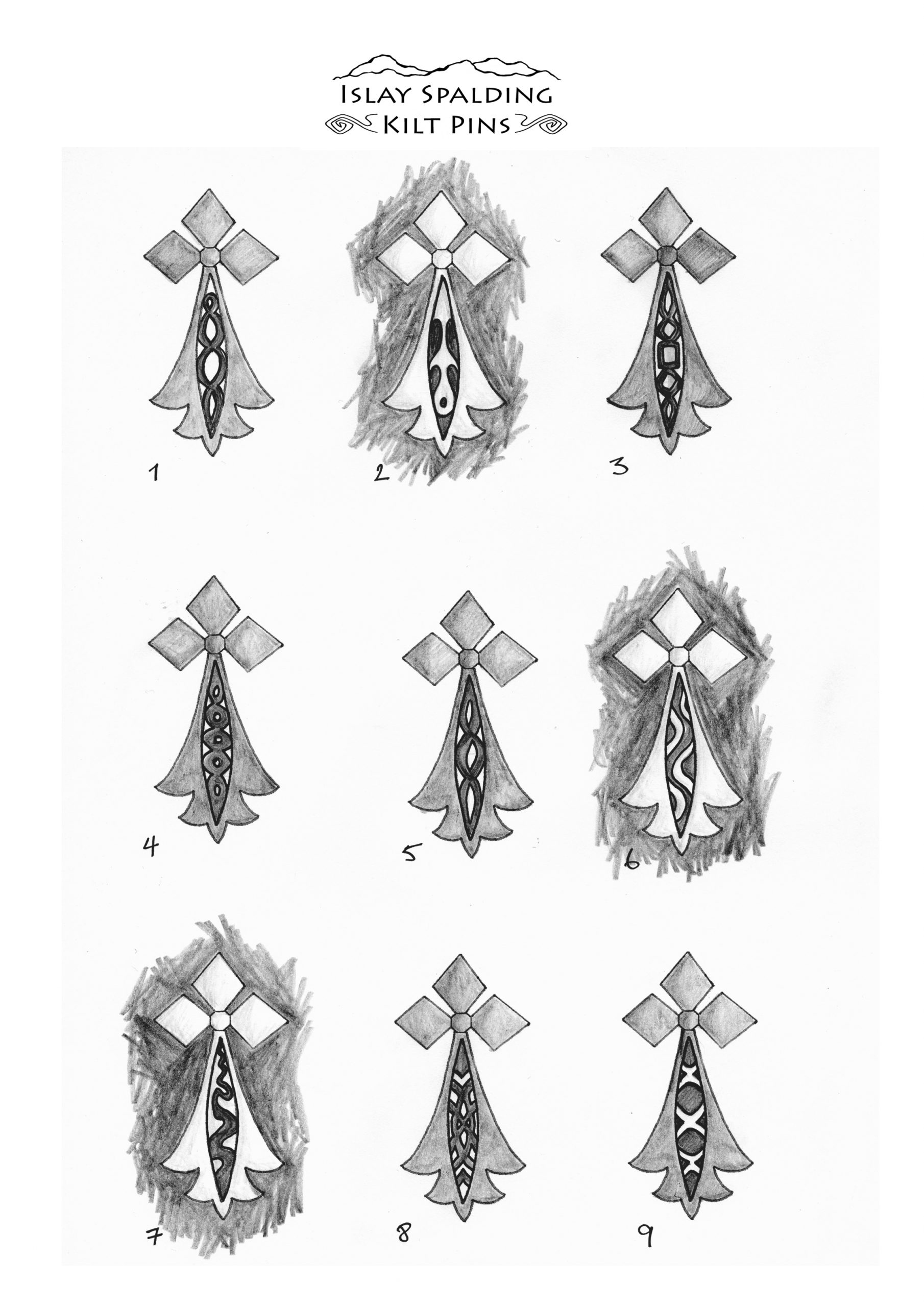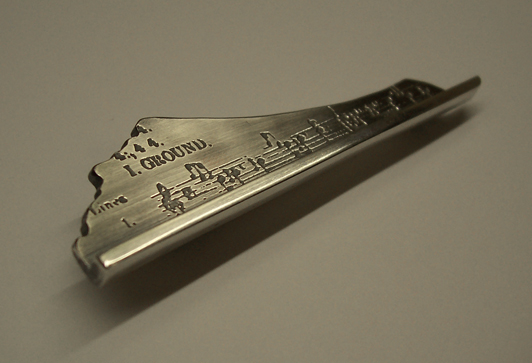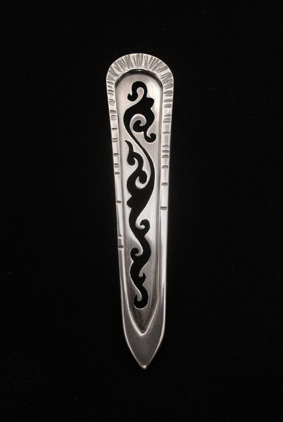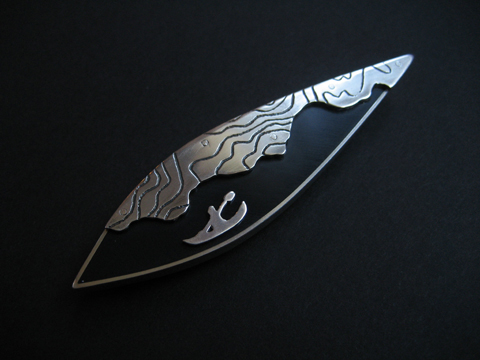Pin intended: Islay Jane Spalding’s bespoke kilt pin designs are catching on
If you think about it, other than tartan itself, the most popular and recognizable item of Highland dress outside of piping and drumming circles is the kilt-pin.
Most people recognize the generic, oversized diaper/nappy pin that adorns the most basic of kilts as a “kilt-pin.” However, pipers and drummers generally don’t put too much thought or creativity into the finishing touches of their piping/drumming suits. Most of us go with cheaply made, nondescript generic stuff, much to The Style Guy’s consternation.
So what happens when someone who has spent her entire life exposed to and learning drumming and playing with pipe bands like MacKenzie Caledonian becomes a professional jeweller with an eye for the unique and creative? Well, you get someone who sees a great way to combine two of her passions to do something different for the piping and drumming world.

And so it is with Islay Jane Spalding of Dundee, Scotland, a 24-year-old graduate of the Duncan Jordanstone College of Art & Design at the University of Dundee, accomplished snare drummer and fiddler, and proponent of all things original and creative. [Disclosure: the author of this article is a Spalding customer.]
She established “Islay Jane Spalding Contemporary Jewellery Design” a few years ago, specializing mainly in her unique lines of custom resin-filled silver and gold pieces for discerning mainstream customers.
Spalding began designing and making kilt pins for fun and family and friends but has gradually increased her work to take on more “bespoke” commissions for a broader audience looking to personalize their Highland wear.”

“When designing a kilt pin for someone, I ask them if they have any ideas how they’d like it to look or what kind of designs they like already, whether they’re mine or something more traditional,” she says. “I have done a couple of contemporary redesigns of clan crests or cap badges. I also find out if they have any hobbies or interests or something personal to them that they would like to see depicted in a kilt pin, or even any pictures or photos of other pieces of jewellery, kilt accessories or anything that they like the aesthetics of.
“It doesn’t have to be something visual; even a favourite tune or place can be enough to get the ideas flowing.”
“It doesn’t have to be something visual; even a favourite tune or place can be enough to get the ideas flowing.” So far, heirloom-quality pieces have emerged that contrast dramatically with predictable junk pins generally worn by pipers and drummers.
Each of Spalding’s kilt-pins go through several design concepts before she actually starts working with precious metals and stones. It’s also good to find out what the clients budget is so I don’t start doing complicated designs that they are not going to be able to afford.
“I do sketches and drawings that I show to my client, usually through e-mail,” she says. “Once an idea is decided I can develop it more if needed and finalize the design, keeping in contact with my client about any design ideas or changes.” In an era of throwaway mass-produced products, Spalding feels that the more ornamental aspects of a piper or drummer’s attire deserve more attention and flare, without being ostentatious.
“I think it’s really important that a kilt-pin is personal. Most people will own only one good one, and you wear only one at a time.”

She has used local scenery, hills and river shapes in her designs, and frequently works around a landscape that has a personal relationship to her client. She has even gone so far as to include a rough piece of quartz in a kilt pin from a client’s favourite beach.
She has even photo-etched a favourite piece of music in to the silver, as with a customer who commissioned a piece to feature the first part of the piobaireachd, “Lament for the Departure of King James.” The process doesn’t happen overnight. The planning and design phase can take anywhere from two weeks to two months depending on her workload and the level of communications.

The actual crafting and hallmarking takes generally three weeks. She’s even been commissioned by one band to design and create a kilt-pin for everyone in the group.
The Grade 3 Pitlochry & Blair Atholl Pipe Band of Pitlochry, Scotland, approached Spalding with a kilt-pin that Pipe-Major Christie Kelly had received as a gift when he was in Brittany. The band wanted to incorporate the “ermine,” Brittany’s national symbol, in the piece. She designed a master version, and then worked with a casting specialist to create them in quantity for the entire band. At this point, Spalding says that there are very few jewellers who also specialize in bespoke kilt-pins and Highland dress accoutrements, although she adds that most jewellers who accept commissions could design a kilt-pin. Kiltpins.com in Renfrewshire, Scotland, is a company that manufactures pieces based mainly on well-kent traditional concepts.

Spalding, however, is content putting her original contemporary concepts to work, staying true to her bespoke approach. She recognizes that there could be more money in designing pieces that could be licensed and mass-produced, but she’d rather not even try to compete. “I think there is so much out there in the mass-produced kilt-pin market that I would find it hard to compete unless I were doing things on a much bigger scale,” she says. “I would like to do some batch-produced designs in the near future which would be a limited number of the same design – maybe 30 of each.
Each would have an edition number and would be priced in the high-end of the market, as you would still be paying for the exclusive design. This would also mean I wasn’t cheapening my name or other designs.” She says that she would consider developing designs for larger companies, “provided they didn’t just sell a load of cheap crap.”
Bespoken like a true artist.


NO COMMENTS YET